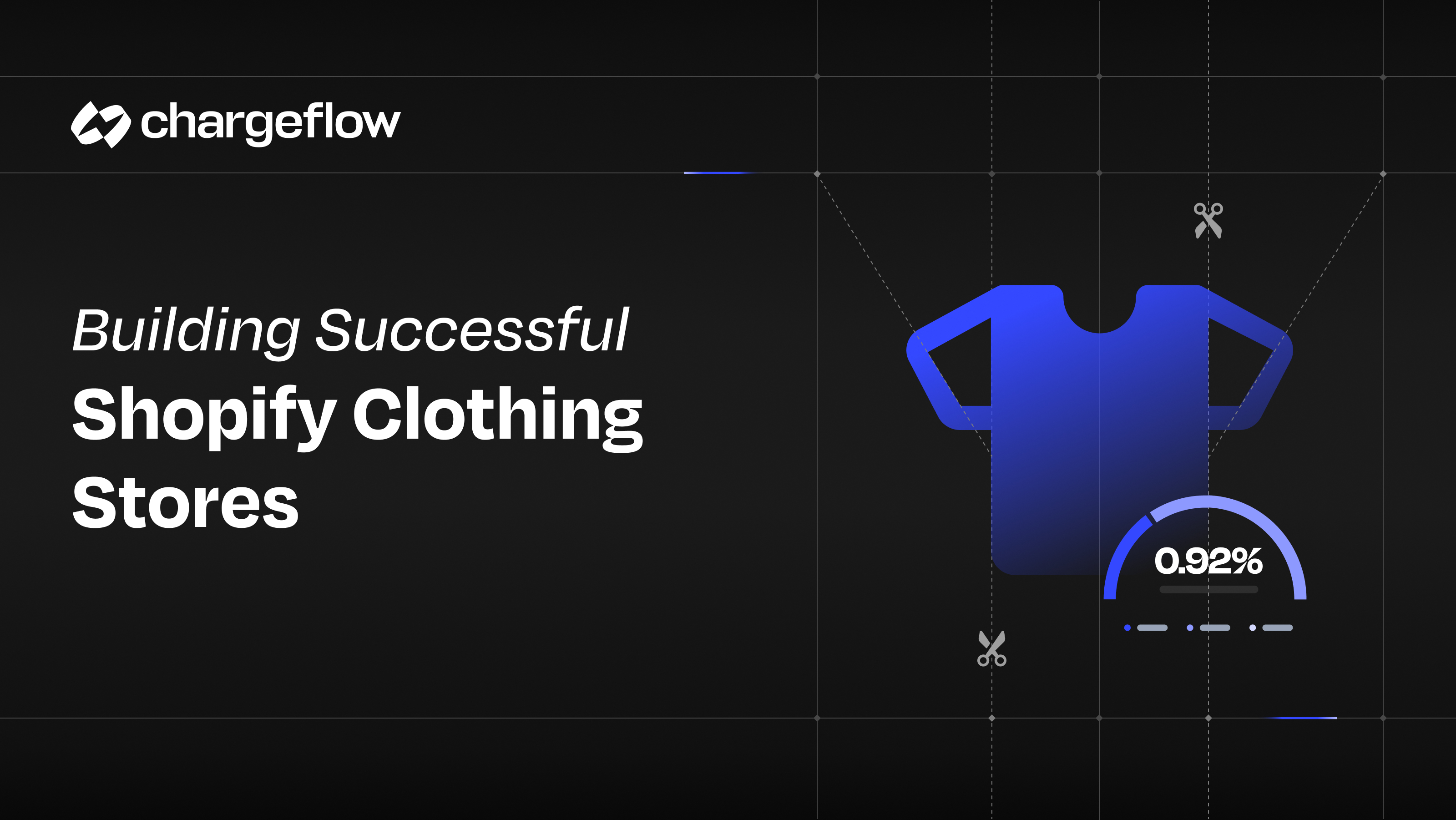The 7 Most Common Chargeback Mistakes Shopify Merchants Still Make (and How to Avoid Them)

Chargebacks?
No longer your problem.
Recover 4x more chargebacks and prevent up to 90% of incoming ones, powered by AI and a global network of 15,000 merchants.
Most Shopify chargebacks are avoidable. Merchants often rely too heavily on default Shopify settings, miss pre-chargeback alerts, respond too slowly, or handle disputes manually. Create a clear SOP, keep billing descriptors recognizable, act on alerts immediately, and use automation tools like Chargeflow to improve win rates, reduce losses, and protect your Shopify Payments account.
Imagine waking up to a Shopify notification that money from a successful sale has suddenly been withdrawn. The customer filed a chargeback, the funds have been pulled back, and without a clear dispute process, you're left absorbing the loss.
Chargebacks cost far more cost far more than the transaction amount. Studies show merchants lose between $3.75–$4.61 for every $1 lost to a chargeback, once fees and operational overhead are included. And with chargeback volumes expected to climb from 261 million in 2025 to 324 million in 2028. That means businesses will continue to lose a portion of their hard-earned revenue to this.
Shopify merchants are especially vulnerable. High order volume makes it harder to spot red flags early, subscription renewals can catch customers by surprise, and international sales create more room for misunderstandings.
The good news: chargebacks rarely happen at random. Most stem from preventable gaps in your workflows.
Below are the 7 most common chargeback mistakes Shopify merchants still make, and how to avoid them.
Mistake #1: Relying on Shopify’s Default Settings
Shopify includes tools like fraud analysis, risk recommendations, and billing descriptors to help prevent disputes. They’re useful, but they’re not enough on their own.
Fraud analysis includes fraud indicators that help determine if an order may be fraudulent, as well as fraud recommendations that categorize orders into low, medium, and high-risk levels before fulfillment.
Descriptors, on the other hand, add a label to each fulfilled order so customers know what their card is being charged for.
However, these settings are not foolproof.
- Fraud recommendations are only available on Shopify Payments or higher-tier plans. Merchants on basic plans lose critical risk insights.
- Fraud indicators lag behind evolving fraud patterns. An order can look clean while still exploiting gaps outside Shopify’s signals.
- Default billing descriptors may show generic text that customers don’t recognize.
Here’s how to strengthen your setup:
- Add a chargeback and fraud solution from the Shopify App Store, such as Chargeflow, to enhance your store's protection against fraud and chargebacks.
- Set up advanced fraud filters that come with your Shopify account.
- Use Chargeflow to automate chargeback management, prevention, and insights.
- Go into your Shopify Payments settings → Manage → Edit bank statement descriptor to customize your billing descriptor manually.
Pro Tip: The fewer third-party tools you use, the better, but review each one regularly to avoid loopholes caused by outdated apps.
Mistake #2: Ignoring Pre-Chargeback Alerts
Shopify’s email notification feature alerts you when a customer creates an order, cancels it, requests a refund, or makes changes. They also send pre-chargeback notifications, which are easy to overlook but critical to act on.
- Shopify notifies you by email and inside your admin dashboard.
- You’ll find cases under Orders → Chargebacks and Inquiries, listed by reason code (e.g., “Fraudulent,” “Product not received”).
- Each case comes with a strict deadline (typically 7–21 days). Evidence must be submitted before that date.
- Shopify provides a template for uploading receipts, tracking numbers, customer communication, and other supporting documents.
The challenge? Many merchants miss these alerts due to notification overload or simply not checking order messages often enough. Once the deadline expires, the cardholder’s bank decides, and the funds are almost always reversed.
To avoid this:
- Address every chargeback alert the same day it arrives. Assign a dedicated person or team to monitor them consistently.
- Use Chargeflow’s alert system to cut through the noise. It delivers customized notifications and can automate pre-chargeback refunds to prevent disputes from escalating.

Mistake #3: No Documented Dispute Playbook
Chargebacks are a type of crisis, especially if they occur frequently in your business and are often the result of fraud. US merchants dedicate nearly 10% of their revenue to combating payment fraud, yet most still rely on a reactive approach instead of a proactive plan.
The risk of not having a playbook includes:
- Inability to assess potential situations that will result in a chargeback.
- Delayed resolution beyond the provided deadline.
- Poor handling can lead to a failed chargeback prevention.
Your SOP (standard operating procedure) should include:
- Notification process: Who monitors the Shopify admin and email for disputes? How often are notifications checked? What escalation steps apply if the primary person is unavailable?
- Categorization: Common types of chargebacks include fraud, duplicate billing, or failed delivery. Include standard response templates or evidence bundles for every kind of response.
- Evidence checklist: Order confirmations, invoices, shipment tracking, signed delivery proof, customer communication logs, refund policies, and product descriptions.
- Response timeline: A specific internal turnaround window, typically 48 hours after notice is received.
- Roles and responsibilities: Who gathers documents, who drafts responses, and who submits via Shopify’s chargeback dashboard.
- Documentation and reporting: A log of chargebacks, outcomes, and reasons to track win/loss ratios and review quarterly to spot trends.
- Customer service escalation: When to reach out directly and scripts to prevent escalation.
Review your SOP quarterly (or twice a year) to keep it aligned with Shopify’s tools, evolving fraud tactics, and your store’s growth.
Mistake #4: Confusing Billing Descriptors
Most people have seen a debit alert on their bank app and thought, “What is this charge?” Even when the purchase is legitimate, confusing or generic billing descriptors trigger unnecessary disputes.
This confusion is a major driver of friendly fraud. Too many of these disputes can even put your merchant account at risk or land you on the MATCH (Merchant Alert to Control High-Risk) list.
Want to dive deeper? Chargeflow covers everything in our free guide, The Truth About Friendly Fraud: How Merchants Are Fighting Back in 2025, to learn why billing confusion is one of the leading triggers of friendly fraud, and shares proven strategies merchants are using to fight back.
How to avoid descriptor confusion:
- Customize your billing descriptor in Shopify Payments with a clear, brand-recognizable name instead of default or abbreviated names.
- Update descriptors with other payment providers like PayPal and Stripe, and other payment providers.
- Keep it consistent across your website, invoices, emails, and receipts so customers instantly recognize it.
- Add support information where possible (such as a phone number or website URL) so customers know who to contact for assistance.
- Use dynamic descriptors for subscriptions (e.g., “GlowSkinCare—Subscription” instead of just “GlowSkinCare”.)
- Send billing reminders before subscription renewals so customers are aware of the upcoming charge.
Pro Tip: Test your descriptor by making a small purchase and checking how it appears on your own bank statement.
Mistake #5: Responding Too Slowly in Shopify Admin
Dispute windows vary by network but are always tight. Responding at the last minute is one of the most costly mistakes merchants make.
The longer you delay:
- The more frustrated your customer becomes.
- The more likely it is for you to miss the case entirely.
- The greater the risk of losing a high-value customer relationship.
According to Chargeflow’s 2025 Psychology of Chargebacks Report, merchants who respond within 48 hours see significantly higher win rates.
How to avoid slow responses:
- Define a strict internal deadline (e.g., 48 hours from receiving the chargeback).
- Automate notifications so your team never misses an alert.
Pro Tip: With Chargeflow's Shopify Integration, you can automatically collect evidence, submit responses through your dashboard, and improve your chances of recovering lost revenue, without the stress of managing everything manually.
Mistake #6: Skipping Second-Chance Opportunities
Many merchants give up on representment because they assume banks always side with the customer, or because gathering receipts, tracking numbers, and messages feels overwhelming. Without a structured system, every dispute feels like starting from scratch.
But skipping representment is expensive. Even winning back a small percentage of disputes can add up to thousands in recovered revenue each year.
According to Chargeflow’s Psychology of Chargebacks Report, just 3% of consumers reported having a chargeback denied because of merchant counter-evidence. That highlights how rare it is for merchants to fight back successfully with manual methods, and why so many give up. Yet with structured processes and automation, merchants can dramatically improve recovery rates.
How to avoid missing second chances:
- Standardize evidence templates for common dispute types.
- Maintain a library of invoices, shipping proof, and communication transcripts.
- Automate representment to ensure every case is submitted consistently and on time.
Pro Tip: Chargeflow’s automation has helped merchants boost win-back rates by up to 300%, turning lost opportunities into recovered revenue.
Bottom line: Don’t give up. Every chargeback you contest is a chance to protect revenue, and automation makes it feasible at scale.
Mistake #7: Managing Chargebacks Manually
Manual processes don’t scale. If you’re already juggling inventory, fulfillment, and customer support, adding chargeback management on top often means missed deadlines, incomplete evidence, and lost revenue.
Why manual workflows fail:
- Win rates are low: Merchants relying on manual processes typically recover fewer than 1 in 10 disputes.
- Time costs are high: Hours are lost pulling receipts, shipment tracking, and support logs for each case.
- Deadlines are strict: One missed submission date, and the dispute is closed for good.
- Each dispute also carries a non-refundable chargeback fee: Usually $20–$30, which adds up quickly for Shopify merchants.
- Manual handling doesn’t scale: Five disputes a month may feel manageable, but once your store grows, the process collapses under volume.
How to fix it:
- Automate evidence collection, deadline tracking, and submissions with Shopify-ready tools.
- Use tools that generate consistent, complete, bank-compliant evidence packages.
- Use Chargeflow’s Shopify integration to auto-generate AI-optimized evidence tailored to each processor and bank.
Automation isn’t just about saving time. With Chargeflow, it’s about protecting revenue, reducing team stress, and actually winning disputes at scale. And when disputes slip through the cracks, your chargeback ratio climbs, putting your Shopify Payments account at risk.
Wrapping up
Chargebacks cost businesses thousands of dollars each year in lost revenue, fees, and wasted time. Poorly managing them not only drains revenue but also damages your brand reputation and increases customer churn.
To protect your Shopify store, avoid common mistakes like relying only on default settings, ignoring pre-chargeback alerts, or responding too slowly to disputes. Instead, build a clear SOP, use advanced fraud filters, set up automated alerts, and keep billing descriptors clear and consistent.
Don’t skip representment opportunities. Every dispute you fight is a chance to recover revenue. And remember, automation isn’t just about saving time; with Chargeflow, it’s about improving win rates, maintaining a healthy chargeback ratio, and protecting your Shopify Payments account.
By avoiding these mistakes and leveraging Chargeflow’s Shopify integration, merchants can reduce chargebacks, recover more revenue, and scale their business with confidence.
👉 Ready to protect your store? Install Chargeflow from the Shopify App Store
and start winning more disputes automatically.

Chargebacks?
No longer your problem.
Recover 4x more chargebacks and prevent up to 90% of incoming ones, powered by AI and a global network of 15,000 merchants.






























.png)








